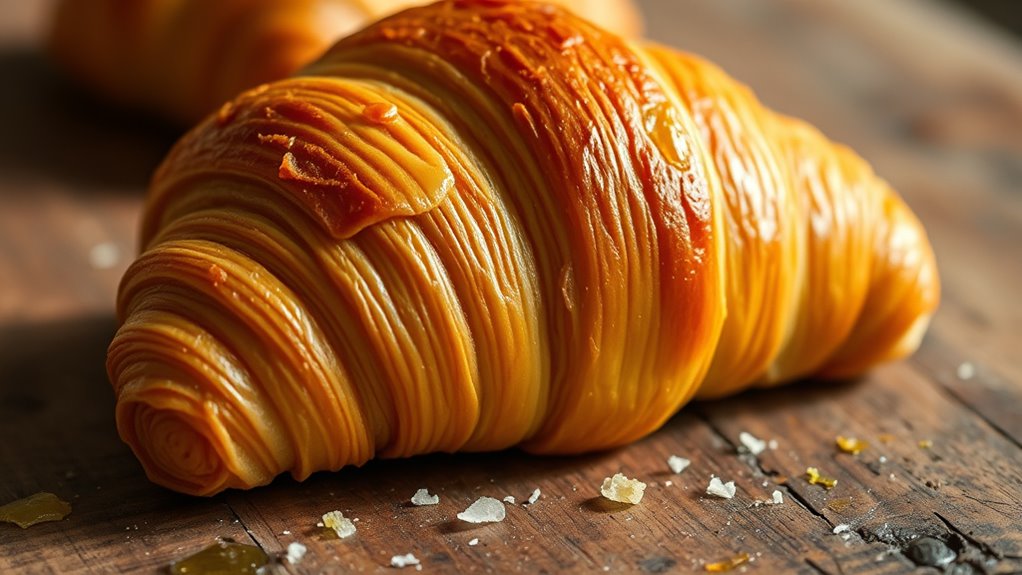To elevate your morning with butter‑perfect croissants, use high-quality, cold butter and keep your dough chilled throughout the process. Master lamination with proper folds, maintain consistent thickness, and incorporate just the right amount of sugar for flavor and browning. Allow time for resting and proofing to develop gluten and flavor. Bake at the right temperature for a crispy, golden crust. Stick with these tips, and you’ll unveil the secrets to bakery‑style croissants.
Key Takeaways
- Use high-quality, cold butter and keep it chilled throughout preparation to ensure flaky, layered croissants.
- Master proper lamination by rolling evenly, folding into thirds, and maintaining consistent pressure for crisp layers.
- Rest and proof dough at the right temperature until it doubles in size, enhancing flavor and achieving perfect rise.
- Bake at 375–400°F for 15–20 minutes, monitoring closely for a golden, crispy crust.
- Use sharp tools for clean cuts and check proofing to ensure uniform, professional-looking croissants with ideal texture.
Use High-Quality, Cold Butter for Flaky Layers

To achieve those coveted flaky layers, it’s essential to use high-quality, cold butter. The butter’s consistency is vital—cold enough to hold its shape during lamination, creating distinct layers. When sourcing your butter, opt for European-style or high-fat varieties, which offer better flavor and flakiness. Avoid softened or melted butter, as it won’t form the necessary layers. Keep your butter chilled until you’re ready to incorporate it into the dough. Proper butter sourcing guarantees you get the right fat content and quality, directly impacting your croissants’ texture. Using cold, high-quality butter is the foundation for achieving that perfect flakiness and rich flavor. Self Watering Plant Pots can help keep your kitchen herbs fresh and thriving, ensuring your butter stays at optimal temperature for lamination. With the right butter, you’ll set yourself up for success in creating bakery-worthy croissants at home.
Master the Art of Lamination With Proper Folding Techniques

Once you’ve prepared your cold, high-quality butter, the next step is mastering the art of lamination through proper folding techniques. Achieving the right dough elasticity is vital; it allows the dough to stretch without tearing during folds. Make sure your butter has a firm yet pliable consistency—too soft, and it’ll seep into the dough, ruining layers; too hard, and it won’t incorporate smoothly. As you roll out the dough, aim for an even thickness, then fold it into thirds or quarters, depending on your recipe. Repeat this process, maintaining consistent pressure to create multiple thin layers. Proper folding builds the flaky layers characteristic of perfect croissants. Additionally, understanding personality traits such as patience and attention to detail can be beneficial during the process. With practice, you’ll develop a feel for the right dough elasticity and butter consistency, leading to beautifully laminated dough every time.
Keep Your Dough and Ingredients Cold Throughout the Process

Maintaining a cold environment for your dough and ingredients is essential for achieving flaky, layered croissants. Cold dough helps preserve the dough’s structure, ensuring proper lamination and preventing butter from melting prematurely. To keep everything chilled, use ice-cold water during mixing and work quickly to limit warmth. Proper ingredient sourcing also matters; choose high-quality butter and fresh flour, stored well before use, to maintain ideal dough hydration. Cold ingredients help you control dough consistency and prevent overworking, which can lead to tough croissants. Throughout the process, chill your dough between folds and before baking to lock in layers. Keeping everything cold ensures your croissants develop that perfect, tender flakiness that makes them irresistible. Incorporating proper storage techniques can further help maintain ingredient freshness and temperature control for optimal results.
Incorporate Just the Right Amount of Sugar for Flavor and Browning
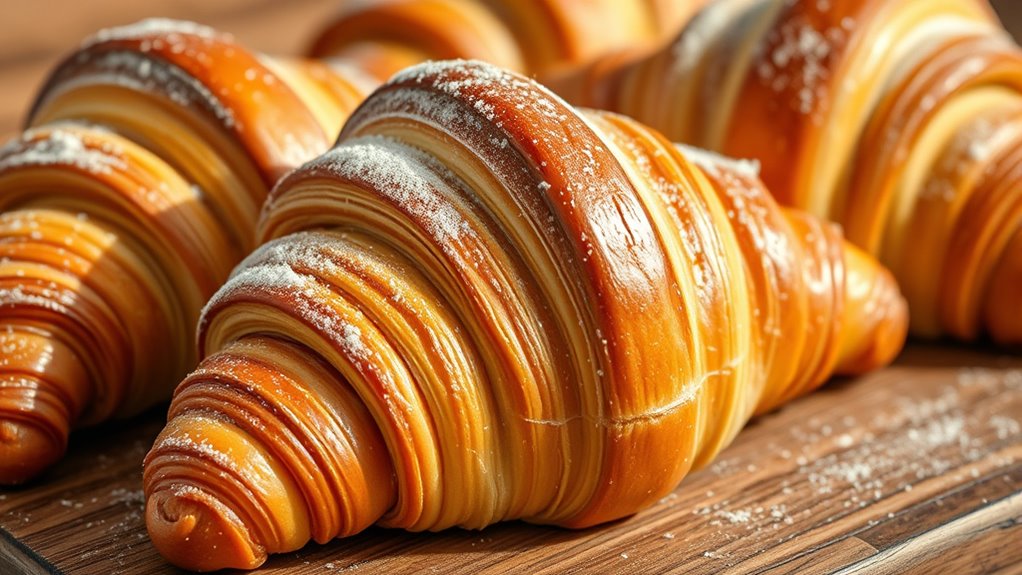
Incorporating the right amount of sugar into your croissant dough enhances flavor and promotes even browning. Too much sugar can cause excessive sugar browning, leading to a dark, overly sweet crust. Conversely, too little may result in a bland taste and dull appearance. Aim for a balanced amount—about 1 to 2 teaspoons per batch—to boost flavor without overpowering the buttery richness. Sugar acts as a flavor enhancer, highlighting the dough’s natural qualities, while also aiding in uniform browning during baking. Keep in mind that the sugar’s contribution to sugar browning ensures your croissants develop an inviting, golden crust. Using the proper baking techniques can help achieve consistent results every time. Adjust the sugar quantity based on your taste preferences, but remember, moderation is key to achieving perfect flavor and a beautiful, buttery finish.
Allow Adequate Resting Periods to Develop Gluten and Flavor

Allowing your dough to rest properly helps develop a strong gluten structure, giving your croissants the perfect flaky texture. It also enhances flavor, making each bite more delicious. Plus, resting prevents the dough from shrinking when baked, ensuring your croissants keep their shape.
Enhances Gluten Structure
To develop a strong gluten network and deepen flavor, giving your dough enough time to rest is vital. Rest allows gluten formation to strengthen, creating a resilient structure that supports flaky layers. During this period, the dough’s thickness becomes more uniform, making it easier to roll out without tearing. Proper resting also facilitates gluten development, which improves dough elasticity and stretchability. Keep in mind that skipping this step can result in dense, tough croissants. Here’s a quick guide:
| Rest Period | Effect on Dough | Key Benefit |
|---|---|---|
| 30 mins | Slight gluten relaxation | Easier shaping |
| 1-2 hours | Enhanced gluten formation | Better dough elasticity |
| Overnight | Deep gluten development | Superior flaky layers |
Trust the resting process to elevate your croissants. Gluten development is essential for achieving the perfect flaky texture.
Improves Flavor Development
Resting your croissant dough not only strengthens its gluten network but also unseals richer flavors. During this period, the butter’s flavor fully develops, giving your croissants a more pronounced buttery richness. The resting time allows enzymes to break down complex carbohydrates, enhancing overall taste. As the dough rests, the butter begins to meld more thoroughly, contributing to a deeper, more aromatic flavor profile. When baked, the prolonged resting supports the caramelization process, creating those irresistible golden-brown layers and enhanced sweetness. Skipping this step can result in a flatter, less flavorful croissant. By allowing adequate resting, you give the dough time to develop complex flavors, ensuring each bite delivers that perfect balance of buttery depth and caramelized richness. Additionally, proper resting can help improve the gluten structure, leading to a more tender and flaky croissant.
Prevents Dough Shrinkage
When you give the dough sufficient time to rest, it develops a strong gluten network that helps prevent shrinkage during shaping and baking. Resting allows the gluten to fully develop, increasing dough elasticity, which makes it easier to handle without tearing or shrinking. Proper gluten development ensures that the dough maintains its shape, reducing the risk of puffing or collapsing in the oven. Skipping this step can result in a dough that’s too tight or too elastic, causing it to shrink back when stretched. By allowing adequate resting periods, you give the gluten time to relax and strengthen, creating stability and structure necessary for perfectly shaped croissants. This patience ultimately leads to a crisp, flaky exterior and a tender, airy interior.
Roll and Fold With Precision to Achieve Even Layers
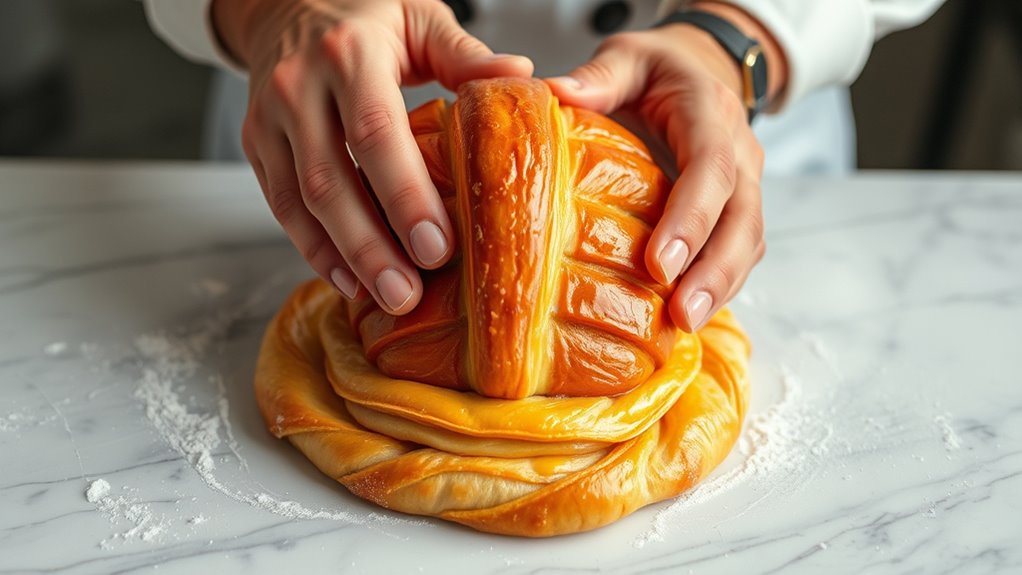
To create perfectly layered croissants, you need to be precise when rolling and folding. Keep the dough at a consistent thickness, use a sharp technique, and guarantee your butter stays cold and firm. These steps help you achieve even layers and flaky perfection in every bite.
Maintain Consistent Thickness
Maintaining a consistent thickness during the rolling and folding process is essential for achieving perfectly layered croissants. If the dough is uneven, layers won’t rise uniformly, affecting texture and appearance. To do this, monitor dough elasticity to ensure it stretches evenly without tearing, and keep butter consistency consistent to prevent uneven layers. Use a rolling pin with adjustable rings to set uniform thickness. Check your dough frequently and adjust pressure as needed. Here’s a quick reference:
| Step | Tip | Why it Matters |
|---|---|---|
| Use adjustable rings | Set to desired thickness before rolling | Ensures uniform layers |
| Check dough elasticity | Gently stretch dough to test | Prevents tearing and uneven layers |
| Maintain butter consistency | Keep butter cold and firm | Ensures even layering and flaky texture |
Additionally, controlling the dough temperature helps in achieving a smooth and pliable dough that is easier to work with. Consistent thickness leads to even layers and perfect croissants.
Use Sharp Folding Technique
Using a sharp folding technique is vital for creating evenly layered croissants. Precise pastry folding ensures consistent layers, which is key to achieving that flaky, buttery texture. To master this, focus on clean, confident folds that maintain the integrity of your dough. Keep your edges sharp and avoid tearing the pastry as you roll and fold. Proper layering techniques prevent uneven thickness and air pockets, resulting in a professional finish. Remember, the goal is smooth, even layers that expand perfectly during baking.
- Use a sharp, well-maintained rolling pin for clean folds
- Apply consistent pressure to keep layers uniform
- Fold with precision, avoiding jagged edges or tears
With these tips, your pastry folding becomes a vital step in elevating your croissants.
Keep Butter Cold and Firm
Ever wonder why your croissants sometimes turn out flaky but uneven? The key is keeping butter cold and firm during the process. Proper butter storage is essential; keep your butter refrigerated until you’re ready to use it. When preparing, use cold butter straight from the fridge to prevent melting, which can cause uneven layers. Cold butter ensures that when you roll and fold, the layers stay distinct and even. If the butter becomes soft or starts melting, chill the dough briefly before continuing. This step helps maintain the integrity of the layers and results in a flaky, buttery croissant. Remember, working with cold, firm butter is the secret to achieving those perfect, even layers that make croissants irresistible. Additionally, understanding the significance of butter temperature can make all the difference in your baking success.
Use a Sharp Knife or Pastry Cutter for Clean Cuts
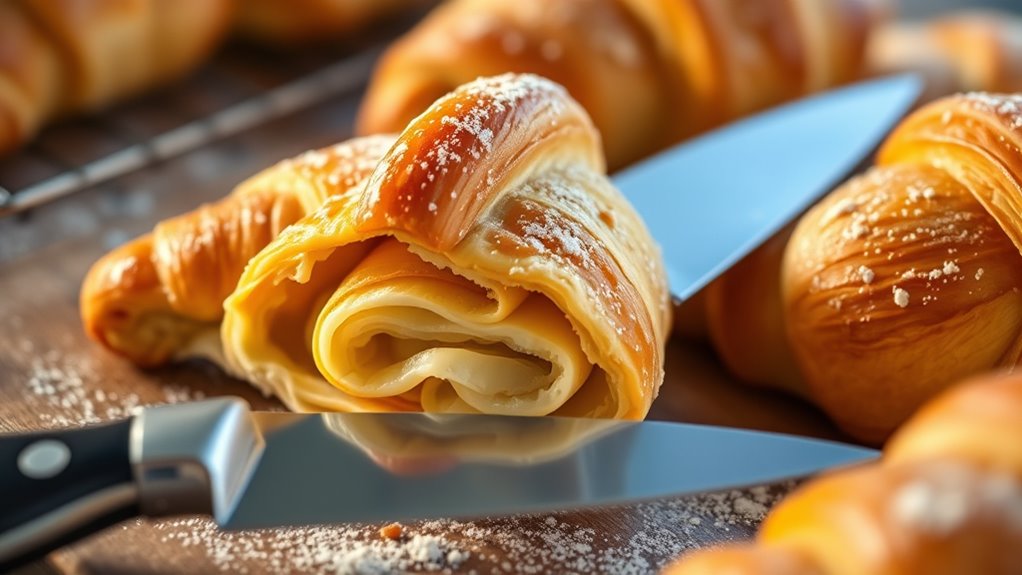
To achieve perfectly shaped croissants, it’s essential to cut the dough with a sharp knife or pastry cutter. Using a pastry knife or a well-honed knife ensures precision cutting, preventing the dough from tearing or squashing. Clean cuts help maintain clean layers and a professional appearance.
Sharp, well-honed knives or pastry cutters are key for clean, precise croissant cuts that ensure professional layers and perfect shape.
To make the most of your tools:
- Use a sharp knife or pastry cutter for smooth, even slices
- Apply steady, confident pressure to avoid jagged edges
- Chill the dough slightly before cutting to improve control
This approach guarantees your croissants will have uniform shapes and a flaky, tender texture. Remember, sharp tools make all the difference in creating neat, precise cuts that elevate your baking game.
Maintain Consistent Thickness for Uniform Croissants
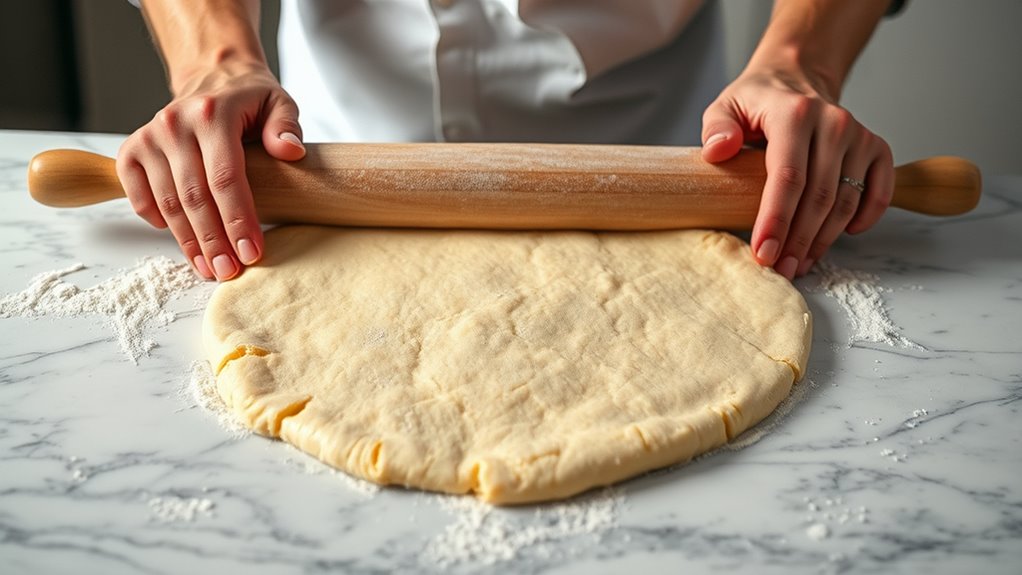
Maintaining a consistent thickness throughout your croissant dough is key to guaranteeing even baking and a uniform final product. When your dough has uniform thickness, heat distributes evenly, preventing overbaking or undercooking in certain areas. To achieve this, regularly check the dough’s consistency as you roll, adjusting pressure as needed. Fresh ingredients play a crucial role; stale flour or butter can affect dough elasticity, making it harder to roll out evenly. Use a rolling pin with guide rings or measure the thickness with a ruler to keep things uniform. Keep your workspace and tools clean and dry to preserve ideal dough consistency. Consistent thickness ensures each croissant bakes evenly, resulting in that perfect, flaky, buttery texture you’re aiming for. Additionally, understanding the importance of proper flour quality can greatly influence how well your dough responds to rolling and shaping.
Practice Proper Proofing for the Perfect Rise
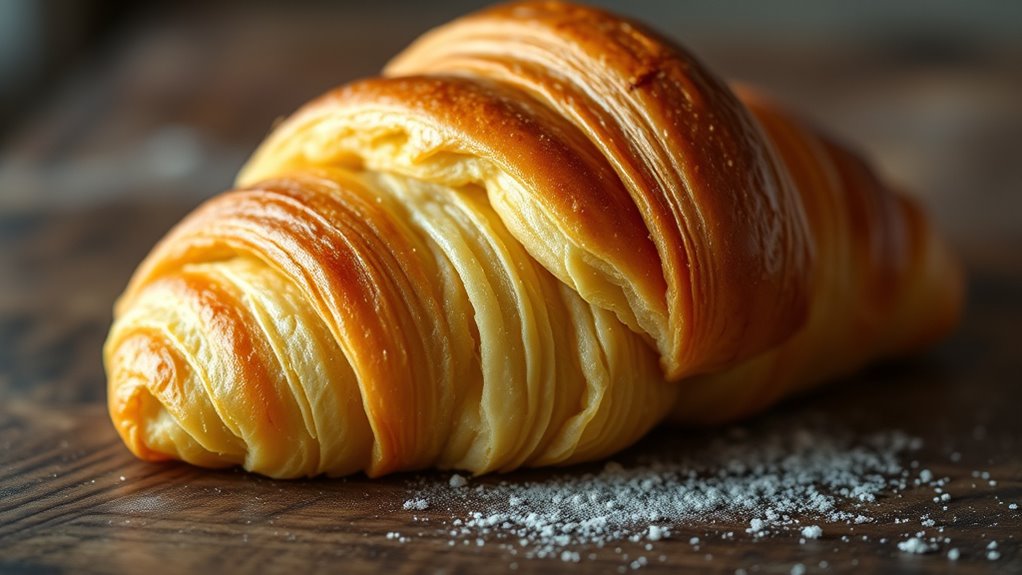
To get your croissants to rise just right, you need to proof them at the right temperature and for the perfect amount of time. Too warm or too long, and they might overproof, losing their fluffiness, while underproofing can leave them dense. Paying close attention to these details guarantees your croissants turn out light, airy, and perfectly crafted. Using proper proofing techniques can significantly enhance the final result.
Optimal Proofing Temperature
Achieving the perfect rise in your croissants depends heavily on the right proofing temperature. The ideal proofing environment encourages ideal fermentation control, helping your dough develop flavor and structure. Too warm, and the dough may overproof, resulting in flat croissants; too cold, and fermentation slows, leaving them dense. Aim for a steady temperature around 75°F (24°C) for consistent results. To maintain this, consider:
- Using a proofing box or warm spot in your kitchen
- Covering dough with a damp cloth to prevent drying
- Monitoring temperature with a thermometer
Keeping the right proofing temperature ensures your croissants rise beautifully, with the perfect flaky layers and buttery texture you desire. Proper fermentation control makes all the difference in elevating your baking game.
Timing for Fluffiness
Timing is key to guaranteeing your croissants turn out fluffy and perfectly risen. Proper proofing allows the dough to develop ideal dough elasticity, which helps achieve that airy, layered texture. As you proof, keep an eye on the dough’s size—it should roughly double without over-expanding. This indicates the butter layering has properly infused, creating the flakiness you desire. Rushing the process can hinder dough elasticity, resulting in dense croissants, while overproofing can cause them to deflate. Use your finger to gently press the dough; if the indentation springs back slowly, it’s ready. Patience during proofing ensures the yeast has adequately risen, producing the perfect fluffiness and a light, buttery crumb. Timing your proof perfectly guarantees a beautifully layered, tender croissant.
Avoid Overproofing
Overproofing your croissants can cause them to deflate and lose their delicate layers, so it’s crucial to recognize the signs of overproofing and stop the process at the right moment. Pay attention to proofing timing; overproofed dough becomes overly puffy and loses its elasticity. When dough elasticity diminishes, it’s a sign that fermentation has gone too far. To avoid overproofing:
- Look for a slight jiggle or soft feel, not a fully expanded, sponge-like surface
- Check if the dough springs back slowly when gently pressed
- Keep an eye on the size—overproofed croissants often double or triple in volume and become very airy
Controlling proofing helps maintain the perfect rise and flaky layers, ensuring your croissants turn out butter‑perfect every time.
Bake at the Right Temperature to Achieve a Golden, Flaky Finish
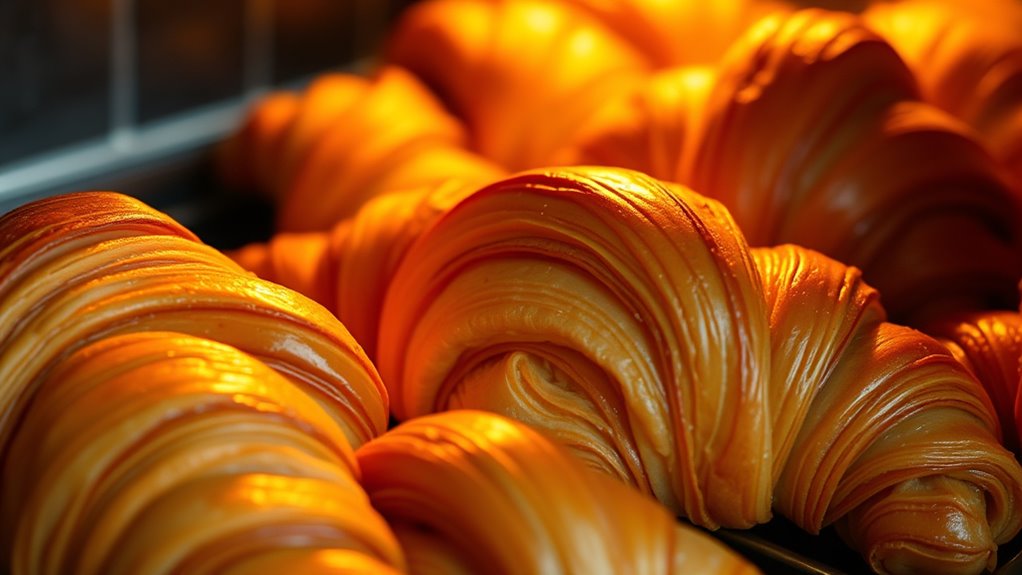
To get that perfect golden, flaky finish on your croissants, you need to bake them at the right temperature. Setting your oven to the correct oven temperature guarantees the croissants brown evenly without burning. Typically, a hot oven around 375°F to 400°F works best. Keep a close eye on the baking duration—usually about 15 to 20 minutes—so the croissants develop a crisp, golden exterior. Too high a temperature can cause burning before the inside is fully cooked, while too low may result in pale, soggy pastries. Use an oven thermometer if needed to monitor the temperature accurately. Proper baking time and temperature are essential to achieving that irresistible, flaky crust and buttery glow that make perfect croissants stand out.
Frequently Asked Questions
How Do I Prevent Butter From Melting During Lamination?
Imagine your butter as a delicate dance partner, needing just the right touch. To *guarantee* it from melting during lamination, keep your butter temperature cool—around 60°F (15°C)—and use precise lamination techniques. Chill your dough and butter frequently, and work quickly but carefully. This balance ensures your butter stays firm enough to create those flaky layers, resulting in perfectly laminated croissants every time.
What Are Common Mistakes to Avoid When Folding Dough?
When folding dough, avoid common mistakes like overmixing, which can lead to tough croissants, and improper folding techniques, causing uneven layers. You should handle the dough gently, keeping it cool to prevent butter from melting or tearing. Make sure to fold evenly and consistently, maintaining the right number of layers. Paying attention to these details guarantees your croissants turn out flaky, buttery, and perfectly layered.
How Can I Tell When Croissants Are Perfectly Proofed?
You can tell when croissants are perfectly proofed by observing visual cues and proofing timing. They should look puffy, airy, and slightly expanded, with a gentle bounce when you lightly press the dough. Typically, proofing takes about 1 to 2 hours at room temperature. Keep an eye on their size and texture, ensuring they’re not over-proofed, which can cause them to collapse or become dense.
What Tools Help Achieve Consistent Croissant Thickness?
Imagine a secret weapon to perfect croissants every time. A pastry roller guarantees you get that ideal, even thickness, while a thickness gauge provides precise control. By using these tools, you avoid uneven layers and achieve consistent, flaky results. The pastry roller smooths out your dough effortlessly, and the gauge keeps your thickness uniform, transforming your baking game and making delightful croissants that impress with every batch.
How Can I Store Croissants to Keep Them Fresh Longer?
To keep croissants fresh longer, you should focus on proper refrigeration techniques and freezing methods. Wrap them tightly in plastic wrap or foil to prevent air exposure, which slows down staling. For longer storage, freeze the croissants in an airtight container or freezer bag, removing as much air as possible. When you’re ready to enjoy them, reheat in the oven for that fresh-baked taste.
Conclusion
By following these secrets, your croissants will turn out as flaky and golden as a sunrise. Think of each step as layering a beautiful painting—patience and attention make all the difference. Keep your ingredients cold, fold with care, and proof just right. With practice, you’ll craft bakery-worthy croissants that make mornings brighter and mouthwatering. So, roll up your sleeves and elevate your baking game—delicious perfection is just a few steps away.
